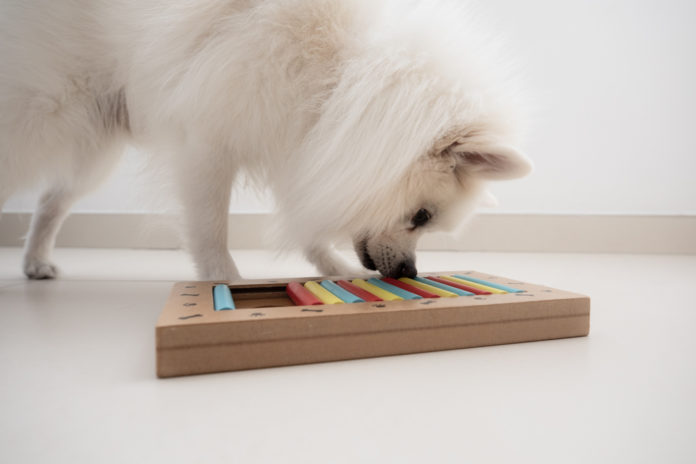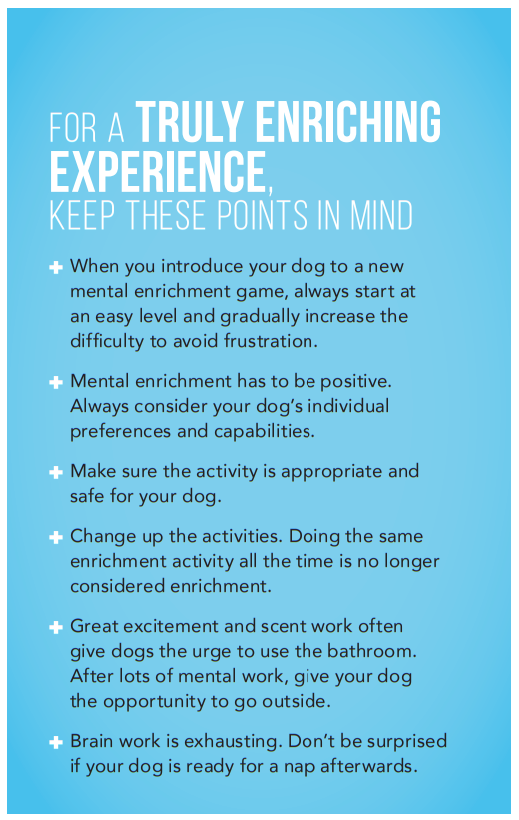Why mental enrichment is so important for dogs

Just like us, dogs can get bored, frustrated, anxious and depressed due to lack of mental stimulation. This article looks at why mental enrichment is so important to your dog, and how you can introduce more variety and fun into his life.
If this pandemic has taught us anything, it’s the importance of social contacts and variety in our lives. Staying home and following the same routine day in and day out, with few social interactions, has left many people feeling bored, frustrated, anxious and depressed. Our dogs can feel the same way when they lack social activities, new experiences, an occupation, and the opportunity to engage in normal canine behaviors. In fact, many canine behavior problems are caused by boredom or a lack of mental stimulation. We now know that mental enrichment is just as important for dogs as physical exercise. Research has shown that increased mental activity results in improved mental health and cognitive function in dogs. It builds confidence, releases stress, and strengthens your mutual bond. In short, your dog will live a happier life. Let’s look at some easy ways to incorporate mental enrichment into your dog’s life.
Add variety to your walks
Dogs are naturally curious and love to explore. Instead of walking around the same block every day, switch it up a bit. Take a new route, visit different parks, or hike new trails so your dog can explore new sights, sounds, and scents. While physical exercise is important, also give him plenty of time to sniff and investigate. This is his way of exploring the world and catching up on the news.
Allow safe social contact
Dogs are social animals and should be given the opportunity to meet people, other dogs, and other animals. While the pandemic has limited our ability – and by extension our dogs’ — to interact with others, you can still allow your dog to be social on walks, even if from a distance. If and when pandemic restrictions allow, enroll in a group dog training class or give him the opportunity to play with other dogs. When appropriate, take him with you on errands, when you meet friends, or go to a pet-friendly coffee shop. Of course, for this type of mental enrichment your dog needs to be friendly and enjoy social interactions. Never force him to interact with anyone. If he shows signs of fear or aggression, work on those issues first.
Provide him with plenty of toys
Give your dog access to a variety of toys, and encourage play. Some dogs enjoy carrying toys around while others like to chew on them. Many like to play tug or fetch with their people. Provide different types of good quality toys made from different materials to see what your dog prefers. Always supervise him with a new toy at first, to make sure it’s safe for her to play with. While dogs can lose interest in their toys over time, this doesn’t mean you need to buy a new toy every week; instead, rotate them to keep them interesting for your dog.
Give your dog a job to do
Many people think that only working breeds need a job to do, but any dog will benefit from using his brain. Teaching your dog obedience or a new trick, doing agility, nose work and other canine sports are all ways to physically and mentally challenge him. But you don’t need to enroll in a class to give your dog a job. Most dogs love to hunt and dig, and there are many ways to allow them to pursue these activities in a non-destructive way. Searching for food is a form of hunting, and food-searching games provide great entertainment for dogs. If you are concerned about your dog’s weight, use healthy treats such as boiled chicken, or a portion of his regular meal, for these activities.
 Fun ways to keep him busy
Fun ways to keep him busy
1. Do a treat search
- While your dog is paying attention to you, say “find it” and toss a treat on the floor. Repeat a few times until your dog understands to look for the treat on the floor.
- Next, make the game a bit more challenging. Have your dog watch you hide the treat (e.g. behind your foot or an object close by). Say “find it” and give him some time to figure it out. It will help if you look towards the hiding spot instead of looking at thedog. Dogs follow our gaze, while looking at them can actually “freeze” them in place. Repeat a few times until your dog understands.
- Gradually increase the level of difficulty and hide treats in different hiding spots before you ask your dog to “find it.” Now he really has to use his nose. The goal is to hide numerous treats around your house or yard and then have your dog search for them. This is a fabulous game for your dog to play when you are busy or need to leave him home alone (just don’t leave him in the yard by himself).
2. Play “peekaboo”
- While you and your dog are in the same room, hide behind a corner or door, then poke your head out, call “peekaboo” and hide again. Your excited tone of voice should prompt her to come looking for you.
- As soon as she finds you, praise her enthusiastically.
- Gradually make the game more challenging. For example, hide in a different room, in a closet, or behind a curtain.
- Finally, hide when your dog is not paying attention to you and call “peekaboo” from your hiding spot.
In this game, your dog uses her ears and nose to find you. It builds confidence as she learns to explore places on her own. Of course, you can play the game in safe areas outside as well. It’s fun, and the whole family can play together.
3. Use food dispensing toys and puzzle games
The pet industry has recognized the need for mental enrichment and offers a wide range of food dispensing toys that can encourage your dog to use problem-solving skills and work for his food. Popular treat or food dispensing toys include treat balls, Kongs, and slow feeders. You can even find elaborate puzzle toys from beginner to expert levels.
Alternatively, you can create enrichment toys with everyday household products, like the following:
- Place small treats in the compartments of a muffin tray and cover them with balls. Your dog will have to use his nose to detect the treats and use problem-solving skills to get to them. This game is easy enough to play with dogs that are new to enrichment games.
- Turn delivery boxes and empty plastic bottles into a fun digging box for your dog. Toss a few treats into the box and cover them with empty plastic bottles and/or balls and let the search begin. You can increase the level of difficulty by stacking several boxes together. If your dog is noise-sensitive and becomes nervous about the noise of the plastic bottles moving in the box, start out with just a few bottles at first. Because the noise is connected to a fun activity and yummy treats, it’s a great way to build a noise-sensitive dog’s confidence over time. If you have an appropriate outdoor space, you can also install a sand box where your dog is allowed to dig for treats and toys.
Incorporating mental enrichment into your dog’s life will increase his happiness and well-being. It allows him to engage in natural behaviors, builds confidence, and gives him a feeling of accomplishment. Best of all, it nixes boredom, anxiety and frustration, and that makes life better for both of you!



